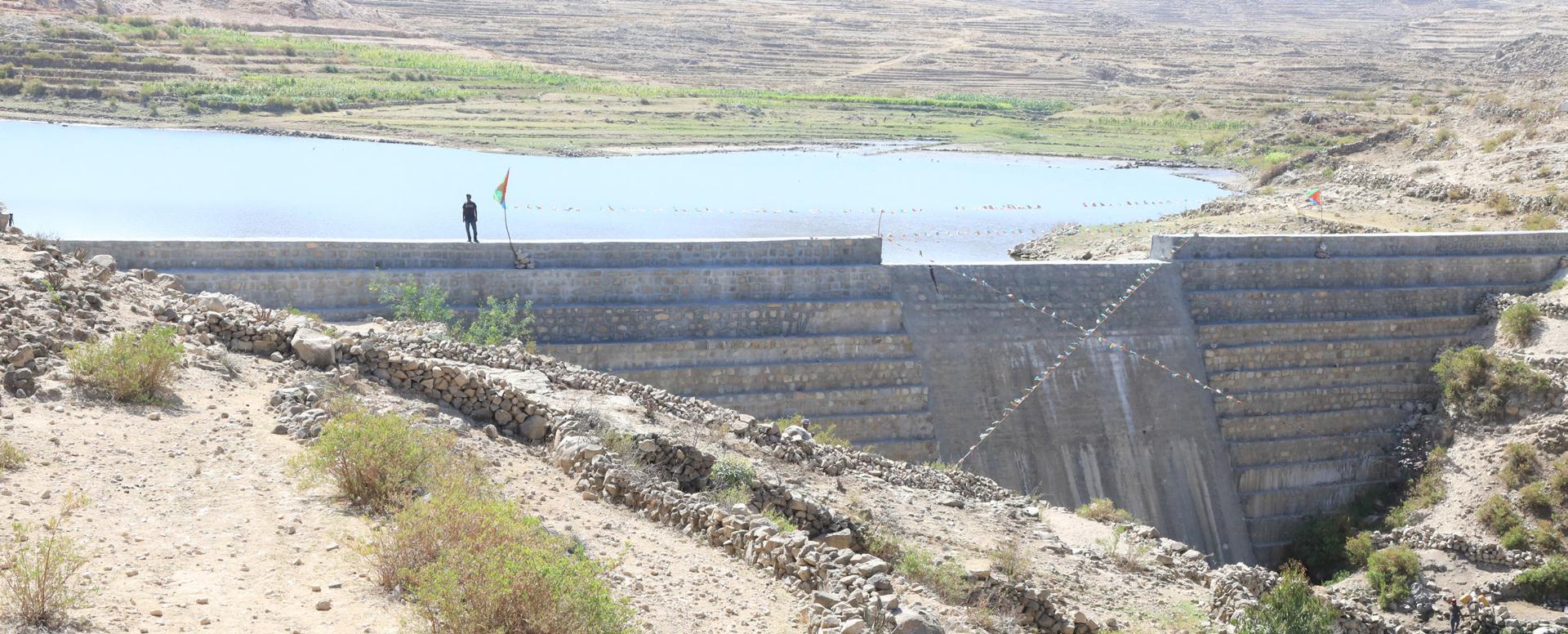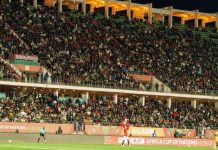Africa-Press – Eritrea. Highlights on the Current Status and Impact of Medium, Small, and Micro Water Reservoirs in Eritrea
The Government of the State of Eritrea (GoSA), from the outset, took resolute initiatives to put in place various water conservation schemes all over the country. This newsletter is, therefore, dedicated to shed light on this ongoing national endeavor based on an interview with Mr. Eyob Gebremeskel, Head of Dams and Diversion Structures Development Unit at the Ministry of Agriculture (MoA), and with representatives of some beneficiaries focusing on the status and impact of small and medium-sized water reservoirs in Eritrea over the last 33 years of independence.
Question (Q): Could you explain the different types of water harvesting and diversion structures so far constructed, and their standards?
Answer (A): Water reservoirs can be constructed in different sizes and structures, and we categorize them according to their water-holding capacity and their contribution to the overall water availability. They are primarily categorized as Diversion Structures, Sub-Surface Dams, Ponds, and Dams.
Q: Could you explain a bit more about their basic differences?
A: Diversion structures are the types that divert top-soil-rich flood waters to adjacent farmlands. They can be constructed just with soil (earthen), gabion, or concrete. The Sheeb Spate Irrigation scheme is a typical example of the existing diversions.
Sub-surface dams: These kinds of dams of different capacities are normally constructed under river beds in hot areas to avoid or minimize evaporation.
Ponds are small earthen shallowly dug water-holding structures Conventional dams – In Eritrea, we have built hundreds of dams over the last three decades. In our case, their sizes can be categorized as follows:
Q: Please give us a picture of the number, water-holding capacity, and impact of water reservoirs at the time of independence?
A: There were almost no diversion structures and sub-surface dams at the time of independence, and the total number of water reservoirs stood at 138. Their average water-holding capacity was limited to 25,000 cubic meters (for ponds), and 300,000 cubic meters (for micro-dams). Their contribution to the agricultural sector was also quite limited.
Q: Could you give us a briefing on the current nature of the country’s water reservoirs?
A: The water-holding structures so far constructed in the country are as follows:
In the Central, Southern, and Anseba administrative regions alone, the number of ponds stands at 361. The number of ponds in the other administrative regions fluctuates considerably
Q: How can the current geographic distribution of water reservoirs be explained concerning the national goal of ensuring social justice?
A: In the beginning, dams used to be constructed on a demand basis coming from the administrative regions. However, with the advent of better knowledge of GIS, the strategy was revised to address equity and social justice, thus ensuring reasonable distribution throughout the country. Of course, issues like agriculture potential, population density, amount of rainfall, catchment area, and above all, needs assessment must take center stage.
Q: What are the underlying strategies that gave rise to such a leap in national water conservation programs?
A: Over the past 14 years, with the revision of the strategy of building several medium and small dams throughout the country, this undertaking was effectively implemented. The rationale was that villages and/or clusters of villages can practice dependable and sustainable agriculture if a source of water is secured. They, then, can transform into small and medium commercial farmers producing crop and livestock products for the market.
Q: To what extent has the Eritrean agriculture sector benefited from the construction of such water reservoirs?
A: Thanks to the number of dams of different sizes constructed (currently to the tune of 810), the production of cereals has increased by 2 folds; and that of vegetables by 6 folds; while fruit production has skyrocketed to 71 times. However, we need to keep up the momentum until every village or cluster of villages throughout the country gets a dependable water source for small, intensive, and integrated farming, through which we look forward to finally achieving safe and nutritious food for everyone; everywhere.
Q: How do you rate the current level of public awareness regarding the requisites of water conservation and its judicious utilization?
A: At this point, I can confidently say that public awareness about soil and water conservation in general, and the construction of water reservoirs in particular, has risen significantly. This is precisely the reason why communities all over are passionately participating in the programs annually.
Q: Given the achievements made thus far in water conservation, what are the major initiatives taken to bring irrigation development to the next level, i.e. both in terms of sustainability and geographical outreach?
A: while continuing construction of water-holding structures, the strategy that has just started is to embark on photo-voltaic powered pressurized (drip or sprinkler) irrigation.
Thanks Mr. Eyob Gebremeskel
The Public Relations Division of the MoA sent Mr. Tesfalem Gebreselassie (member of the Fre-Tsaeri Magazine editorial board) to five regions of the country to collect some testimonials from the beneficiaries of the micro-dams which were built in collaboration with African Development Bank (AfDB), and the excerpts are as follows;
Temamio Micro-dam
Temamio is a small village located in the Adi-Mealem Administrative Area of the Central Region. Currently, it is inhabited by around 200 agrarian and nomadic people. Due to its landscape, destruction of its plentiful vegetation cover, and as a result declining soil fertility, was aggravated by powerful water runoffs. Some decades have passed since the community suffered even from a lack of adequate potable water supply. Shortage of water resources has also impacted negatively on its longstanding horticultural activities.
Ms. Senait Kelete who lived in the village with her husband for 35 years by carrying out small-scale horticultural activities said, “Living in our village, before the construction of the long-awaited dam, was extremely difficult.”
Ms. Fatna Idris, from the same village, added, “Especially over the past two decades, we used to periodically experience a shortage of potable water supply almost right after the conclusion of the rainy season, i.e. as of October. In April and May, we used to fill our jerrycans with cups. There were times when we had to queue the whole night around wells to fetch water.”
Mr. Kidane Baire, a horticulture farmer, also explained that, apart from ensuring a sustainable water supply both for human consumption, the water reserve from Temamio Dam has revitalized irrigated agricultural activities, especially horticulture, in the area. Around forty farmers are enthusiastically engaged in fruit and vegetable production, because the underground water reserve in the area has been enriched, beyond expectation, just like what the village used to be 70 years ago.
Deqi-Gebru Dam
Of all the dams that were constructed by the MoA and its stakeholders in Anseba Region, Deqi-Gebru Dam is among the most exemplary ones, in light of its significant impact on irrigation development and improvement of the livelihood of the local community, according to Mr. Ghebremeskel Tewolde, the Acting Director General of the Agriculture and Land Department of the regional administration.
Deqi-Gebru village, in Adi- Tekelezan Sub-zone, is almost three kilometers away from the Asmara-Keren main road. The elders of the village remember that the area had a good vegetation cover before the profound deforestation during the war for national independence. Mr. Bereketab Haile, Administrator of the village, personally testified that especially the area where the dam was constructed had a stream with a continuous flow.
“Despite this,” Mr. Bereketab added, “We had only one water well which was dug at the right place by the Italians. Yet, with the degradation of the area’s cover, underground water resource was depleted and thus we were prone to a critical shortage of potable water for several years.”
Mr. Bereketab went on to explain that because of the restoration of the village’s former beautiful ecological status has now assumed its old beauty.
Ms. Senait Misgina, member of the administrative body in the village, elaborated. “Concerning household consumption, shortage of water exerted more pressure on women early on. Therefore, as a result of this experience women were more keen on the construction of the dam. Now women members of our community are enjoying an easy lifestyle thanks to the water that the dam has secured. Besides several women have started small-scale irrigation farming.”
Explaining that there are around 150 water pumps that are owned by farmers in the village, Mr. Teklebrhan Tesfazghi, another inhabitant of the village, on his part, explained that the shortage of fuel is a major challenge on the part of the farmers. Hence, he called on the regional administration to extend the necessary support so that the farmers could practice irrigation through gravity from a raised reservoir in a more efficient way.
Afetella Dam
Afetella Dam is the first one of its kind to be constructed in the Shakat Administrative Area of the Barentu Sub-zone of the Gashbarka Region. Ms. Greta Bado Shidin, the Administrator of the area, told the same story of land and water resource degradation over the past decades. Therefore, the inhabitants went through a difficult experience when they were compelled to travel for three hours to fetch drinking water. At the same time, livestock owners went through terrible times.
Asserting that potable water supply for the local community has been met sustainably following the construction of Afetella Dam, Ms. Greta said, “Although horticultural activities have not been practiced among us well before, some of our community members are looking forward to it. I think part of the water reserve from the dam gives us a chance to practice small-scale irrigated farming.”
Nakfa Dam
Considering the activities that were undertaken during the armed struggle for independence, soil and water conservation activities have a long history among the residents of the Nakfa Sub-zone. It is to be recalled that two micro-dams were constructed in the Baqla and Endilal areas at that time, while the members of the First Round of the National Service constructed three water reservoirs of equivalent sizes in the area. Despite this, a prolonged rainfall shortage, coupled with the fact that more water reservoirs were not constructed in the area, gave rise to a grave condition of water scarcity.
“When the government shared with us its plan of constructing a water reservoir of medium size in the Wegriet area (Nakfa Dam), the residents of Nakfa, happily, and enthusiastically participated in the construction of the dam said Ibrahim Mohammed Ali, administrator of Nakfa town.
Ms. Jim’eya Osman, a resident of the town, on her part, pointed out, “Once the dam’s construction was concluded and it held water, we were completely relieved from consuming both scarce and extremely hard water. Many members of our community also enjoyed employment opportunities in the course of its construction. Our livelihood has improved in various ways too. What’s left, now, is progressing to and practicing irrigated agriculture”
Mr. Ibrahim further disclosed that the area is witnessing significant improvement in underground water resources, and commended all actors who contributed to the realization of this goal.
Check dams in Adi-Kodo Administrative Area
“We have a typical agricultural community which is characterized by a great culture of hard work. We have been striving to sustain our longstanding horticultural practice of one century against all odds: i.e. intensive water scarcity and lack of appropriate material resources,” said Mr. Leake Gherebgergish, the Administrator of Adi-Kodo Administrative Area, Emni-Haili Sub-zone. He attributes the cause of this to the fact that intense water runoffs in the area were not managed properly in good time, and hence serious deforestation that took place.
Rev. Habtom Tesfamariam, an inhabitant of the area, explains, “When the government put in place check dams along the Mai- Nefahi River, the situation has changed for the better. We now have enough water both for human and livestock consumption, while horticultural activities are being rejuvenated.”
The experts who supervised the construction of this water reservoir confirmed that there was strong communal participation throughout the process. They also assert that the community members are highly encouraged by the enriched underground water resource which positively impacted fruit and vegetable production, and call for a stepped-up engagement through regular community-based soil and water conservation activities.
For More News And Analysis About Eritrea Follow Africa-Press







